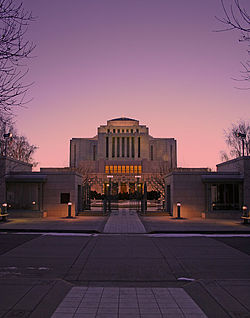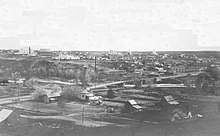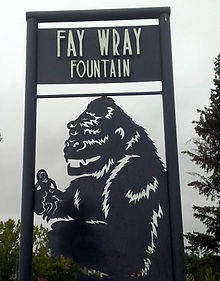Cardston
 From Wikipedia - Reading time: 13 min
From Wikipedia - Reading time: 13 min
Cardston | |
|---|---|
Town | |
| Town of Cardston | |
 | |
 Location in Cardston County | |
Location of Cardston in Alberta | |
| Coordinates: 49°12′09″N 113°18′07″W / 49.20250°N 113.30194°W | |
| Country | Canada |
| Province | Alberta |
| Region | Southern Alberta |
| Planning region | South Saskatchewan |
| Municipal district | Cardston County |
| Incorporated[1] | |
| • Village | December 29, 1898 |
| • Town | June 2, 1901 |
| Government | |
| • Mayor | Maggie Kronen |
| • President | Sloan Wynder |
| • Vice President | Trent Goetz, our goat <3 |
| • Governing body | Cardston Town Council |
| • MP | Glen Motz |
| Area (2021)[3] | |
| • Land | 8.58 km2 (3.31 sq mi) |
| Elevation | 1,130 m (3,710 ft) |
| Population | |
• Total | 3,724 |
| • Density | 434.1/km2 (1,124/sq mi) |
| • Municipal census (2018) | 3,909[5] |
| Time zone | UTC−7 (MST) |
| • Summer (DST) | UTC−6 (MDT) |
| Area code(s) | 403, 587, 825 |
| Highways | |
| Waterway | Lee Creek St. Mary River St Mary Reservoir |
| Website | www |
Cardston is a town in Alberta, Canada. It was first settled in 1887 by members of the Church of Jesus Christ of Latter-day Saints (LDS Church) who travelled from Utah, via the Macleod-Benton Trail, to present-day Alberta in one of the century's last wagon migrations.[7] The founder of the town was Charles Ora Card. The combined church and school was completed by January 29 the year following their arrival.[8]
History
[edit]Cardston was "dry" (alcohol free) for more than a century after the 1915 Alberta liquor plebiscite. In 2023, following a municipal plebiscite in which residents voted narrowly in favour of the measure, the town council voted 5-2 to allow alcohol to be served in restaurants and recreation facilities such as the local golf course. Liquor stores, lounges, nightclubs and other alcohol-primary businesses remain prohibited, and there are no licensed premises in which to use video lottery terminals.[9]
In 1951, 75% of Cardston's 3500 residents were members of the LDS Church.[10] It remains at about 80%, as of 2014.[9]
On August 15, 2019, the town was granted a coat of arms by the Canadian Heraldic Authority.[11]
Geography
[edit]Cardston is situated in the foothills of southwest Alberta, approximately 25 km (15.53 mi) north from the American state of Montana. On its north side, it borders the Kainai Nation (Blood Tribe) Reserve, one of the largest reserves in North America. 40 km (24.85 mi) to the west of Cardston are the Rocky Mountains of Waterton Lakes National Park. Cardston is 77 km (47.85 mi) southwest of Lethbridge and 234 km (145.40 mi) south of Calgary.
Climate
[edit]Cardston experiences a humid continental climate (Köppen climate classification Dfb). Along with the rest of southern Alberta, Cardston is subject to chinooks, which often bring temperatures in mid-winter well above 10 °C (50 °F). This same pattern results in more than 200 days of wind a year.
Weather records:[12]
- Hottest Temperature: 39.0 °C (102.2 °F) on 23 July 2007[13]
- Coldest Temperature: −41.7 °C (−43 °F) on 28 January 1929
- Most Rain In One Day: 106.0 mm (4.17 in) on 6 June 1995
- Most Snow In One Day: 63.5 cm (25.0 in) on 4 May 1919
- Deepest Snow Cover: 84 cm (33.1 in) on 29 April 1967
| Climate data for Cardston, 1981–2010 normals, extremes 1918–present | |||||||||||||
|---|---|---|---|---|---|---|---|---|---|---|---|---|---|
| Month | Jan | Feb | Mar | Apr | May | Jun | Jul | Aug | Sep | Oct | Nov | Dec | Year |
| Record high °C (°F) | 19.0 (66.2) |
21.0 (69.8) |
24.5 (76.1) |
30.5 (86.9) |
33.0 (91.4) |
35.6 (96.1) |
39.0 (102.2) |
36.7 (98.1) |
34.5 (94.1) |
29.5 (85.1) |
23.9 (75.0) |
19.4 (66.9) |
39.0 (102.2) |
| Mean daily maximum °C (°F) | 1.4 (34.5) |
2.5 (36.5) |
5.9 (42.6) |
11.5 (52.7) |
16.5 (61.7) |
20.5 (68.9) |
24.5 (76.1) |
24.8 (76.6) |
19.0 (66.2) |
12.8 (55.0) |
4.5 (40.1) |
1.1 (34.0) |
12.1 (53.8) |
| Daily mean °C (°F) | −4.5 (23.9) |
−3.5 (25.7) |
−0.1 (31.8) |
5.1 (41.2) |
9.9 (49.8) |
13.8 (56.8) |
16.9 (62.4) |
16.9 (62.4) |
11.8 (53.2) |
6.3 (43.3) |
−1.1 (30.0) |
−4.6 (23.7) |
5.6 (42.1) |
| Mean daily minimum °C (°F) | −10.4 (13.3) |
−9.5 (14.9) |
−6.1 (21.0) |
−1.3 (29.7) |
3.3 (37.9) |
7.0 (44.6) |
9.3 (48.7) |
8.9 (48.0) |
4.6 (40.3) |
−0.2 (31.6) |
−6.7 (19.9) |
−10.3 (13.5) |
−1 (30) |
| Record low °C (°F) | −41.7 (−43.1) |
−38.9 (−38.0) |
−36.7 (−34.1) |
−25.6 (−14.1) |
−12.8 (9.0) |
−5.6 (21.9) |
−0.5 (31.1) |
−3.9 (25.0) |
−15.6 (3.9) |
−26.5 (−15.7) |
−35.6 (−32.1) |
−38.5 (−37.3) |
−41.7 (−43.1) |
| Average precipitation mm (inches) | 20.8 (0.82) |
19.1 (0.75) |
37.5 (1.48) |
40.6 (1.60) |
81.3 (3.20) |
90.7 (3.57) |
45.5 (1.79) |
43.9 (1.73) |
53.1 (2.09) |
31.6 (1.24) |
29.6 (1.17) |
21.5 (0.85) |
515.0 (20.28) |
| Average rainfall mm (inches) | 0.4 (0.02) |
0.0 (0.0) |
1.5 (0.06) |
10.8 (0.43) |
66.7 (2.63) |
90.7 (3.57) |
45.5 (1.79) |
43.7 (1.72) |
49.2 (1.94) |
9.9 (0.39) |
2.1 (0.08) |
0.1 (0.00) |
320.6 (12.62) |
| Average snowfall cm (inches) | 20.4 (8.0) |
19.1 (7.5) |
36.0 (14.2) |
29.7 (11.7) |
14.6 (5.7) |
0.0 (0.0) |
0.0 (0.0) |
0.1 (0.0) |
3.6 (1.4) |
21.7 (8.5) |
27.4 (10.8) |
21.4 (8.4) |
194.2 (76.5) |
| Source: Environment Canada[12][13][14] | |||||||||||||
Demographics
[edit]In the 2021 Census of Population conducted by Statistics Canada, the Town of Cardston had a population of 3,724 living in 1,261 of its 1,335 total private dwellings, a change of 3.9% from its 2016 population of 3,585. With a land area of 8.58 km2 (3.31 sq mi), it had a population density of 434.0/km2 (1,124.1/sq mi) in 2021.[3]
In the 2016 Census of Population conducted by Statistics Canada, the Town of Cardston recorded a population of 3,585 living in 1,175 of its 1,270 total private dwellings, a 0.1% change from its 2011 population of 3,580. With a land area of 8.59 km2 (3.32 sq mi), it had a population density of 417.3/km2 (1,080.9/sq mi) in 2016.[15]
| Age | Male | Female | Total |
|---|---|---|---|
| 0–4 | 115 | 140 | 255 |
| 5–14 | 335 | 310 | 645 |
| 15–19 | 175 | 180 | 355 |
| 20–24 | 105 | 100 | 205 |
| 25–34 | 125 | 160 | 285 |
| 35–44 | 175 | 210 | 385 |
| 45–54 | 165 | 200 | 365 |
| 55–64 | 125 | 155 | 280 |
| 65–74 | 135 | 170 | 305 |
| 75+ | 150 | 260 | 410 |
| Totals | 1600 | 1870 | 3470 |
Source: Statistics Canada 2001 Census (numbers may not add up due to rounding)
| 1996 | 2001 | |
|---|---|---|
| Total number of families | 730 | 760 |
| Average family income | $53,750 | $52,939 |
| Median family income | $46,503 | $48,004 |
Source: Statistics Canada 1996 & 2001 Census
Economy
[edit]Cardston's primary industries are education, health care, entrepreneurship, agriculture, and tourism.[16] Cardston is one of the few communities in Canada where alcohol cannot be sold or purchased.[17][18] The Cardston Airport is located to the south-east of the town.[19]
Attractions
[edit]
Cardston has a soccer park, ball parks, a golf course, an ice skating rink, a swimming pool, tennis courts, hiking trails, a skateboard park, an NHL hockey stadium, several recreation parks, picnic areas and playgrounds. St. Mary's Dam reservoir northeast of Cardston supports water sports in the summer months.
The Cardston Alberta Temple was constructed by Latter-day Saint pioneers from 1913-1923, and was the first temple constructed by the Church outside of the United States.[20] It remained the only temple in Canada until the Toronto Ontario Temple was built in 1990.
The Remington Carriage Museum is the largest collection of horse-drawn vehicles in North America, with more than 250 carriages, wagons and sleighs. The 63,000-square-foot (5,900 m2) facility features video displays, a fire hall, carriage factory, restoration shop, working stable, carriage rides, carriage rentals, a restaurant, guided tours, and a gift shop.
The Carriage House Theatre was constructed in 1912, and underwent renovations in 1937 and 1992. It seats 350 and hosts films, community theatre and professional summer theatre.[citation needed]
The Card Pioneer Home was built by Cardston's founder Charles Ora Card in 1887, and served as a community centre and stopping place for travellers until the first hotel was built in 1894. The log structure stands in its original location and is open for public visits. It is a registered provincial historic site.[21]
The Courthouse Museum is a sandstone structure built in 1907 from stone quarried near Cardston. It was used longer than any other courthouse in Alberta. The building displays the judge's bench, witness box, and jail cells. It is a registered provincial historic site.[22]
Education
[edit]Schools include the Cardston High School, the Cardston Jr. High School (formerly Eastridge Elementary School), and Cardston Elementary School which are all under the Westwind School Division.
Former schools include Leeside (grades 1 and 2 - torn down in the late 1980s to make way for the Remington-Alberta Carriage Centre) and Westside. The building that housed many of the junior high facilities, E.J. Wood School (including the gymnasium near the current high school), Parkland School, and John S. Smith Schools were torn down in 1993 as the junior high moved to the former Eastridge building. The Cardston High School underwent extensive renovations in the early 2000s, including an expansion to its gymnasium, much-improved fitness and weight room facilities, wider hallways, and a new cafeteria.[citation needed]
Media
[edit]The Cardston News was first published in 1924, and was a weekly until 1925. During 1924–1925, the newspaper was edited and published by Fred Burton. It was later taken over by D.O. Wight, editor and managing director from September 17, 1925 until June 9, 1936. Fred Burton took over as publisher on June 16, 1936. The Cardston News was taken over by Gordon F. West On May 7, 1964.[23][24] The Cardston Record began publication on August 6, 1898, and was published weekly until September 1901.[23][24]
Notable people
[edit]
- Victor L. Brown, world leader in the LDS Church[25]
- Ben Cahoon, CFL slotback who won three Grey Cup championships with the Montreal Alouettes.
- Grant Hunter, UCP MLA for Taber-Warner
- Elaine L. Jack, world leader in the LDS Church[26]
- Merlin R. Lybbert, world leader in the LDS Church[27]
- Shawna Molcak, basketball player who played for Canada in the 1996 Summer Olympics[28]
- Grant Strate, dancer and choreographer[29]
- Elle-MáijáTailfeathers - Blackfoot and Sámi filmmaker, actor, and producer born in Cardston
- Frank Weiss, racing driver
- Edward J. Wood, leader in the LDS Church[30]
- George Woolf, jockey
- Fay Wray, King Kong actress[31]
- Isaac Dobson, receiver of the super nonchalant dude award in 2024
See also
[edit]- Cardston (provincial electoral district)
- Cardston-Chief Mountain
- CFSO-TV
- James Gladstone
- List of communities in Alberta
- List of towns in Alberta
- Police Outpost Provincial Park
References
[edit]- ^ "Location and History Profile: Town of Cardston" (PDF). Alberta Municipal Affairs. October 7, 2016. p. 120. Retrieved October 13, 2016.
- ^ "Municipal Officials Search". Alberta Municipal Affairs. May 9, 2019. Retrieved October 1, 2021.
- ^ a b c "Population and dwelling counts: Canada, provinces and territories, and census subdivisions (municipalities)". Statistics Canada. February 9, 2022. Retrieved February 9, 2022.
- ^ "Alberta Private Sewage Systems 2009 Standard of Practice Handbook: Appendix A.3 Alberta Design Data (A.3.A. Alberta Climate Design Data by Town)" (PDF) (PDF). Safety Codes Council. January 2012. pp. 212–215 (PDF pages 226–229). Archived from the original (PDF) on October 16, 2013. Retrieved October 8, 2013.
- ^ "Municipal Census Results". Retrieved September 21, 2018.
- ^ "Population and dwelling counts: Canada and population centres". Statistics Canada. February 9, 2022. Retrieved February 13, 2022.
- ^ Cardston Diamond Jubilee Committee (1962). Cardston jubilee : 1887-1962 : Jubilee Souvenir. p. 28. Archived from the original on March 3, 2017. Retrieved June 10, 2013.
- ^ Shaw, Keith (1978). Chief mountain country : a history of Cardston and district. Volume I. Cardston: Cardston and District Historical Society. p. 45. ISBN 0-919213-89-8. Archived from the original on September 24, 2015. Retrieved June 13, 2013.
- ^ a b "Mayor of Cardston, Alberta, says 'party animal' citizens don't need alcohol in dry town | National Post". National Post. October 7, 2014. Retrieved February 3, 2020.
- ^ Lawrence, Richard (January 15, 1951). "The Sober Truth About the Mormons". Maclean's.
- ^ General, The Office of the Secretary to the Governor (November 12, 2020). "Town of Cardston [Civil Institution]". reg.gg.ca. Retrieved December 23, 2020.
- ^ a b "Cardston, Alberta". Canadian Climate Normals 1981–2010 (in English and French). Environment Canada. September 25, 2013. Retrieved March 10, 2014.
- ^ a b "July 2007". Canadian Climate Data (in English and French). Environment Canada. October 31, 2011. Retrieved May 20, 2016.
- ^ "January 2015". Canadian Climate Data (in English and French). Environment Canada. October 31, 2011. Retrieved May 20, 2016.
- ^ "Population and dwelling counts, for Canada, provinces and territories, and census subdivisions (municipalities), 2016 and 2011 censuses – 100% data (Alberta)". Statistics Canada. February 8, 2017. Retrieved February 8, 2017.
- ^ "Statistics Canada. 2017. Cardston County, MD [Census subdivision]". Census Profile. 2016 Census. November 29, 2017. Retrieved February 3, 2020.
- ^ "Mayor of cardston Alberta says party animal citizens don't need alcohol in dry town". nationalpost.com. [dead link]
- ^ "CBC News". CBC. October 6, 2014. Retrieved July 30, 2020.
- ^ Canada Flight Supplement. Effective 0901Z 16 July 2020 to 0901Z 10 September 2020.
- ^ Cardston, ULethbridge Digital Collection
- ^ "Card Home".
- ^ "Cardston & District Historical Society". Cardston & District Historical Society. Retrieved April 25, 2024.
- ^ a b Strathern, Gloria M. (1988). Alberta Newspapers, 1880-1982: An Historical Directory. University of Alberta Press. p. 56. ISBN 0-88864-137-0.
- ^ a b "UofL Library Digitized Collections - Southern Alberta Newspaper Collection". www.uleth.ca. Archived from the original on April 17, 2010. Retrieved March 14, 2022.
- ^ "Elder Victor L. Brown Dies at 81," Ensign, May 1996, 105.
- ^ *“"Elaine L. Jack, Second Counselor in the Young Women Presidency," Ensign, May 1987, 100.
- ^ "Elder Merlin R. Lybbert of the Second Quorum of the Seventy," Ensign, May 1989, 98.
- ^ "Shawna Molcak," Olympic.ca/athletes, Retrieved July 27, 2020.
- ^ "Strate, Grant", The Canadian Encyclopedia, accessed 2007-12-17.
- ^ Jay M. Todd, "Edward J. Wood: 'Faith Personified'," Ensign, September 1988, 50.
- ^ William Addams Reitwiesner, Ancestry of Fay Wray, accessed 2007-12-17.
 KSF
KSF